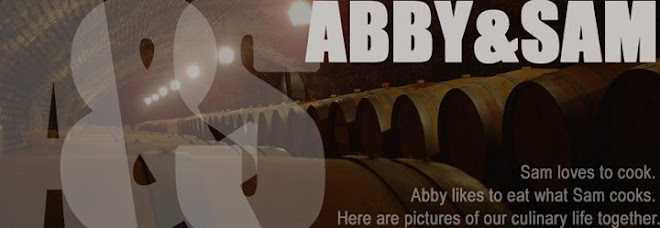-Spaghettini*
-Salted pork belly**
-Parmessan and pecorino romano cheese.
-Garlic
-White wine
-Parsley
-Eggs
-Salt and pepper
Cut the salted pork or pancetta into lardons (you can sort of see the shape from the picture above...small rectangles), roughly chop up a clove of garlic, and cook together over medium heat. You don't need to add any oil to the pan since the lardons will render plenty of fat. I don't remember the exact portions I used.
Grate equal portions of parmessan and pecorino in a bowl (total about 1/2 cup), add a few turns of coarsely ground pepper and a tablespoon of chopped parsley.
Crack a couple of eggs, preserving the yolks. You'll need one for each serving.
When the lardons begin to crisp up, remove as much fat as possible (do this by removing from heat, scooping the lardons to one side of the pan, keeping in place with your cooking spoon, and pouring all of the fat out). The more fat your remove, the cleaner the finished product will taste. Return the pan to heat and deglaze with a dash (1/8-1/4 cup) of white wine. Let this cook down until the wine is almost completely reduce. Remove from heat.
Boil the pasta in heavily salted water. After a couple of minutes, begin checking. You want the pasta to be perfectly al dente, so you have to check often. It can go from perfect to overcooked in a few seconds. When the pasta is done, drain and toss with the cheese/parsley mixture and lardons in a large bowl. It would be a good idea to warm the bowl in the oven, or just warm it with the boiling pasta water.
Portion out each serving into separate bowls (also warmed), top each serving with an egg yolk, and garnish with parsley and additional cheese and pepper.
To eat, break the yolk and mix in with the pasta. If the pasta is still hot (this is why warming all of the bowls is important), the egg will cook as it's stirred in.
*I prefer the thinner spaghettini. If you can get your hands on a brand called Anastasio, use this. In my opinion, this is the best stuff out there. If you can't find this, go with De Cecco
**If you can't find salted pork belly, use pancetta, but only if you can get it cut thick (about 1/4"). If you can't get pancetta, use really high quality, thick cut bacon. If you can't find that, don't bother making this. It won't be good. Bacon has a really strong, smoky flavor that will overpower the dish, and you want the finished product to exhibit a balance between the pasta, cheese, and pork/pancetta/bacon. Pancetta and salted pork belly have less obtrusive tastes. If using bacon, one option would be to cut back the potion.





